Use of a Novel Deep Learning Open-Source Model for Quantification of Ki-67 in Breast Cancer Patients in Pakistan: A Comparative Study between the Manual and Automated Methods
Abstract
:1. Introduction
2. Methodology
Statistical Analysis
3. Results
4. Discussion
5. Conclusions
Author Contributions
Funding
Institutional Review Board Statement
Informed Consent Statement
Data Availability Statement
Acknowledgments
Conflicts of Interest
References
- Alataki, A.; Zabaglo, L.; Tovey, H.; Dodson, A.; Dowsett, M. A simple digital image analysis system for automated Ki67 assessment in primary breast cancer. Histopathology 2021, 79, 200–209. [Google Scholar] [CrossRef] [PubMed]
- Davey, M.G.; Hynes, S.O.; Kerin, M.J.; Miller, N.; Lowery, A.J. Ki-67 as a prognostic biomarker in invasive breast cancer. Cancers 2021, 13, 4455. [Google Scholar] [CrossRef] [PubMed]
- Robertson, S.; Acs, B.; Lippert, M.; Hartman, J. Prognostic potential of automated Ki67 evaluation in breast cancer: Different hot spot definitions versus true global score. Breast Cancer Res. Treat. 2020, 183, 161–175. [Google Scholar] [CrossRef] [PubMed]
- Abubakar, M.; Orr, N.; Daley, F.; Coulson, P.; Ali, H.R.; Blows, F.; Benitez, J.; Milne, R.; Brenner, H.; Stegmaier, C.; et al. Prognostic value of automated KI67 scoring in breast cancer: A centralised evaluation of 8088 patients from 10 study groups. Breast Cancer Res. 2016, 18, 104. [Google Scholar] [CrossRef] [PubMed]
- Nielsen, T.O.; Leung, S.C.; Rimm, D.L.; Dodson, A.; Acs, B.; Badve, S.; Denkert, C.; Ellis, M.J.; Fineberg, S.; Flowers, M.; et al. Assessment of Ki67 in breast cancer: Updated recommendations from the international Ki67 in breast cancer working group. JNCI J. Natl. Cancer Inst. 2021, 113, 808–819. [Google Scholar] [CrossRef]
- Hida, A.I.; Omanovic, D.; Pedersen, L.; Oshiro, Y.; Ogura, T.; Nomura, T.; Kurebayashi, J.; Kanomata, N.; Moriya, T. Automated assessment of Ki-67 in breast cancer: The utility of digital image analysis using virtual triple staining and whole slide imaging. Histopathology 2020, 77, 471–480. [Google Scholar] [CrossRef]
- Rimm, D.L.; Leung, S.C.Y.; McShane, L.M.; Bai, Y.; Bane, A.L.; Bartlett, J.M.S.; Bayani, J.; Chang, M.C.; Dean, M.; Denkert, C.; et al. An international multicenter study to evaluate reproducibility of automated scoring for assessment of Ki67 in breast cancer. Mod. Pathol. 2019, 32, 59–69. [Google Scholar] [CrossRef]
- Volynskaya, Z.; Mete, O.; Pakbaz, S.; Al-Ghamdi, D.; Asa, S.L. Ki67 quantitative interpretation: Insights using image analysis. J. Pathol. Inform. 2019, 10, 8. [Google Scholar] [CrossRef]
- Boyaci, C.; Sun, W.; Robertson, S.; Acs, B.; Hartman, J. Independent clinical validation of the automated Ki67 scoring guideline from the International Ki67 in Breast Cancer Working Group. Biomolecules 2021, 11, 1612. [Google Scholar] [CrossRef]
- Zhong, F.; Bi, R.; Yu, B.; Yang, F.; Yang, W.; Shui, R. A comparison of visual assessment and automated digital image analysis of Ki67 labeling index in breast cancer. PLoS ONE 2016, 11, e0150505. [Google Scholar] [CrossRef]
- Cho, W.C. Digital Pathology: New Initiative in Pathology. Biomolecules 2022, 12, 1314. [Google Scholar] [CrossRef] [PubMed]
- Ghahremani, P.; Li, Y.; Kaufman, A.; Vanguri, R.; Greenwald, N.; Angelo, M.; Hollmann, T.J.; Nadeem, S. Deep learning-inferred multiplex immunofluorescence for immunohistochemical image quantification. Nat. Mach. Intell. 2022, 4, 401–412. [Google Scholar] [CrossRef] [PubMed]
- Ghahremani, P.; Marino, J.; Dodds, R.; Nadeem, S. DeepLIIF: An Online Platform for Quantification of Clinical Pathology Slides. In Proceedings of the IEEE/CVF Conference on Computer Vision and Pattern Recognition 2022, New Orleans, LA, USA, 18–24 June 2022; pp. 21399–21405. [Google Scholar]
- Ghahremani, P.; Marino, J.; Hernandez-Prera, J.; de la Iglesia, J.V.; Slebos, R.J.; Chung, C.H.; Nadeem, S. An AI-Ready Multiplex Staining Dataset for Reproducible and Accurate Characterization of Tumor Immune Microenvironment. In Proceedings of the International Conference on Medical Image Computing and Computer-Assisted Intervention (MICCAI), Vancouver, BC, Canada, 25 May 2023. [Google Scholar]
- Liu, Y.; Han, D.; Parwani, A.V.; Li, Z. Applications of Artificial Intelligence in Breast Pathology. Arch. Pathol. Lab. Med. 2023, 147, 1003–1013. [Google Scholar] [CrossRef]
- Acs, B.; Leung, S.C.; Pelekanou, V. Analytical Validation of an Automated Digital Scoring Protocol for Ki67. In Proceedings of the International Multicenter Collaboration Study, San Antonio Breast Cancer Symposium, San Antonio, TX, USA, 4–10 December 2018. P4-02-01. [Google Scholar]
- Stålhammar, G.; Robertson, S.; Wedlund, L.; Lippert, M.; Rantalainen, M.; Bergh, J.; Hartman, J. Digital image analysis of Ki67 in hot spots is superior to both manual Ki67 and mitotic counts in breast cancer. Histopathology 2018, 72, 974–989. [Google Scholar] [CrossRef] [PubMed]
- Klauschen, F.; Wienert, S.; Schmitt, W.D.; Loibl, S.; Gerber, B.; Blohmer, J.U.; Huober, J.; Rüdiger, T.; Erbstößer, E.; Mehta, K.; et al. Standardized Ki67 Diagnostics Using Automated Scoring—Clinical Validation in the GeparTrio Breast Cancer Study Clinically Validated Automated Ki67 Scoring. Clin. Cancer Res. 2015, 21, 3651–3657. [Google Scholar] [CrossRef]
- Stålhammar, G.; Martinez, N.F.; Lippert, M.; Tobin, N.P.; Mølholm, I.; Kis, L.; Rosin, G.; Rantalainen, M.; Pedersen, L.; Bergh, J.; et al. Digital image analysis outperforms manual biomarker assessment in breast cancer. Mod. Pathol. 2016, 29, 318–329. [Google Scholar] [CrossRef]
- Stålhammar, G.; Martinez, N.F.; Lippert, M.; Tobin, N.P.; Mølholm, I.; Kis, L.; Rosin, G.; Rantalainen, M.; Pedersen, L.; Bergh, J.; et al. Dynamics of genomic clones in breast cancer patient xenografts at single-cell resolution. Nature 2015, 518, 422–426. [Google Scholar]
- Gerlinger, M.; Rowan, A.J.; Horswell, S.; Larkin, J.; Endesfelder, D.; Gronroos, E.; Martinez, P.; Matthews, N.; Stewart, A.; Tarpey, P.; et al. Intratumor heterogeneity branched evolution revealed by multi region sequencing. N. Engl. J. Med. 2012, 366, 883–892. [Google Scholar] [CrossRef]
- Ekholm, M.; Beglerbegovic, S.; Grabau, D.; Lövgren, K.; Malmström, P.; Hartman, L.; Fernö, M. Immunohistochemical assessment of Ki67 with antibodies SP6 and MIB1 in primary breast cancer: A comparison of prognostic value and reproducibility. Histopathology 2014, 65, 252–260. [Google Scholar] [CrossRef]
- Lindboe, C.F.; Torp, S.H. Comparison of Ki-67 equivalent antibodies. J. Clin. Pathol. 2002, 55, 467–471. [Google Scholar] [CrossRef]
- Rexhepaj, E.; Brennan, D.J.; Holloway, P.; Kay, E.W.; McCann, A.H.; Landberg, G.; Duffy, M.J.; Jirstrom, K.; Gallagher, W.M. Novel image analysis approach for quantifying expression of nuclear proteins assessed by immunohistochemistry: Application to measurement of oestrogen and progesterone receptor levels in breast cancer. Breast Cancer Res. 2008, 10, R89. [Google Scholar] [CrossRef] [PubMed]
- Lujan, G.M.; Savage, J.; Shana’Ah, A.; Yearsley, M.; Thomas, D.; Allenby, P.; Otero, J.; Limbach, A.L.; Cui, X.; Scarl, R.T.; et al. Digital pathology initiatives and experience of a large academic institution during the coronavirus disease 2019 (COVID-19) pandemic. Arch. Pathol. Lab. Med. 2021, 145, 1051–1061. [Google Scholar] [CrossRef] [PubMed]
- Zehra, T.; Shams, M.; Ahmad, Z.; Chundriger, Q.A.; Ahmed, A.; Jaffar, N. Ki 67 Quantification in Breast Cancer by Digital Imaging AI Software and its Concordance with Manual Method. J. Coll. Physicians Surg. Pak. 2023, 33, 544–547. [Google Scholar] [PubMed]
- Zehra, T.; Parwani, A.; Abdul-Ghafar, J.; Ahmad, Z. A suggested way forward for adoption of AI-Enabled digital pathology in low resource organizations in the developing world. Diagn. Pathol. 2023, 18, 68. [Google Scholar] [CrossRef] [PubMed]
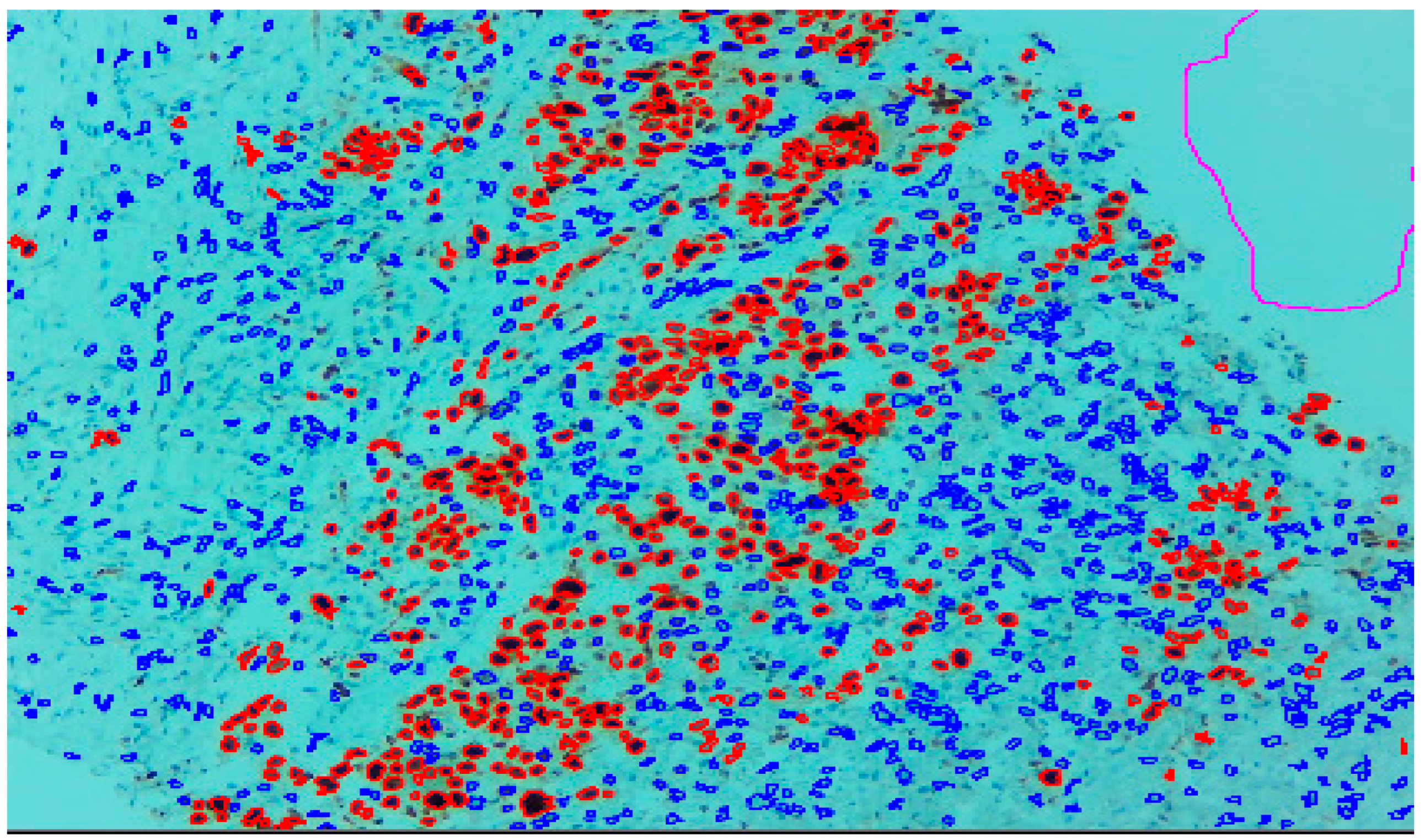
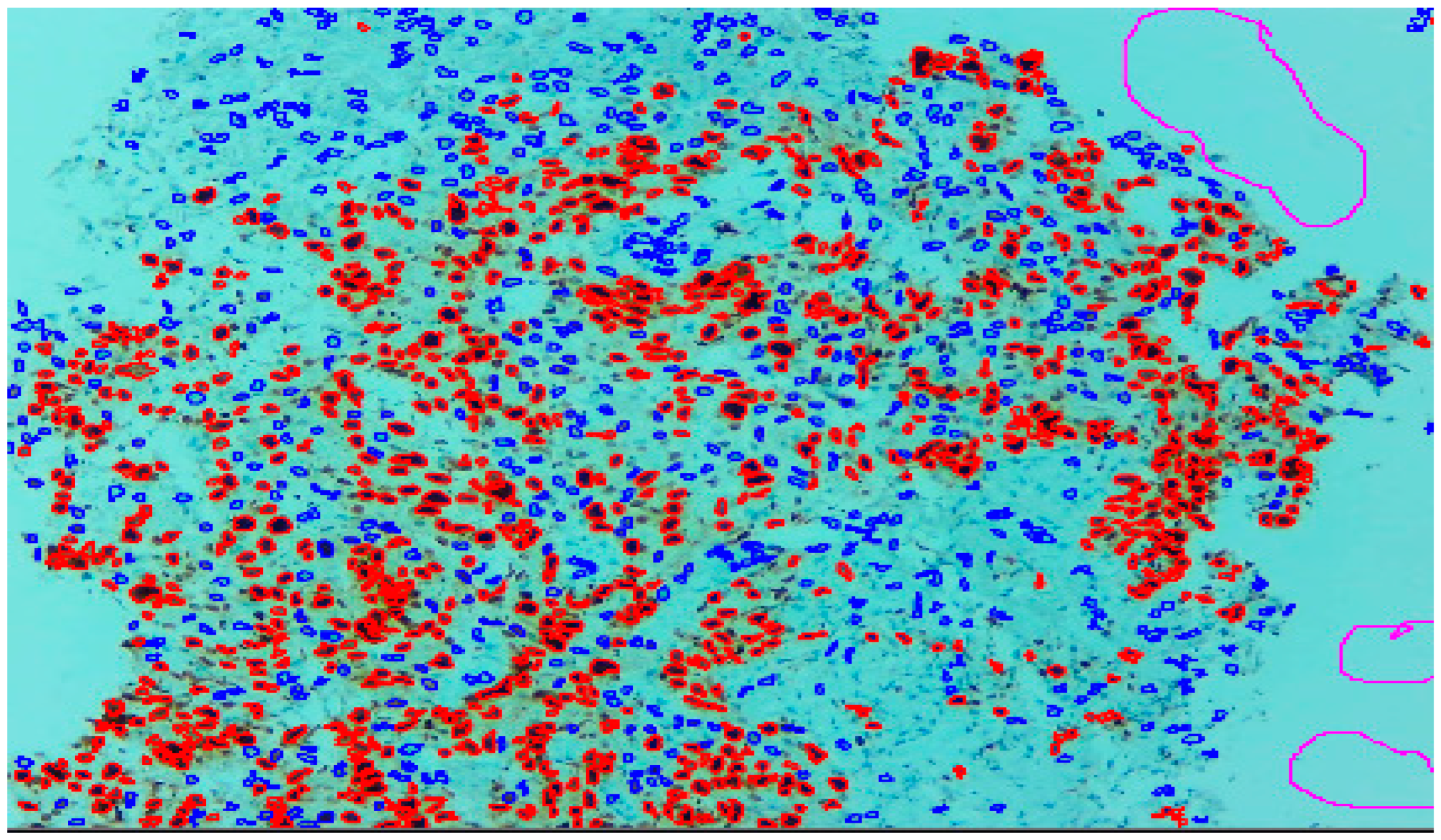
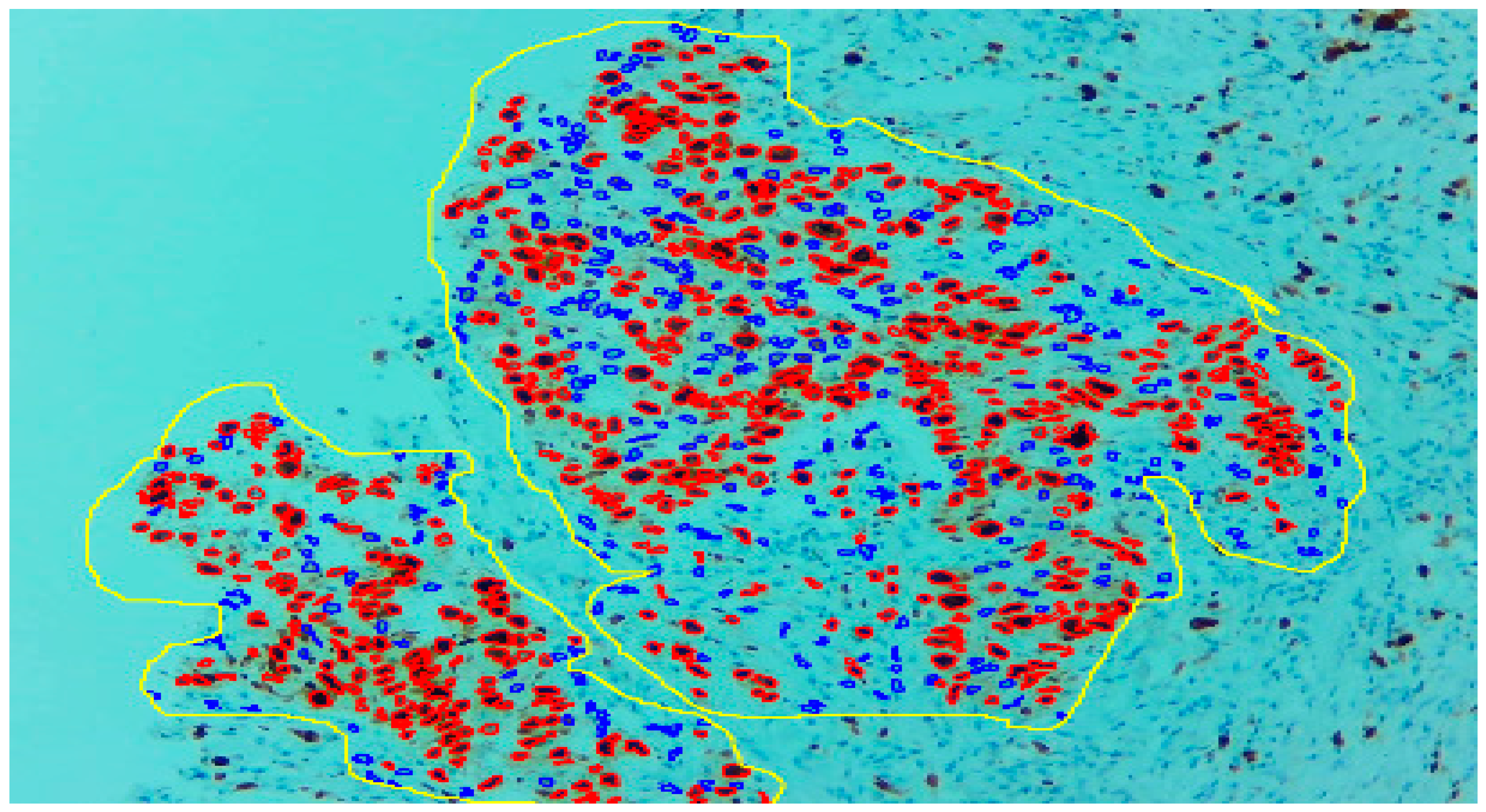
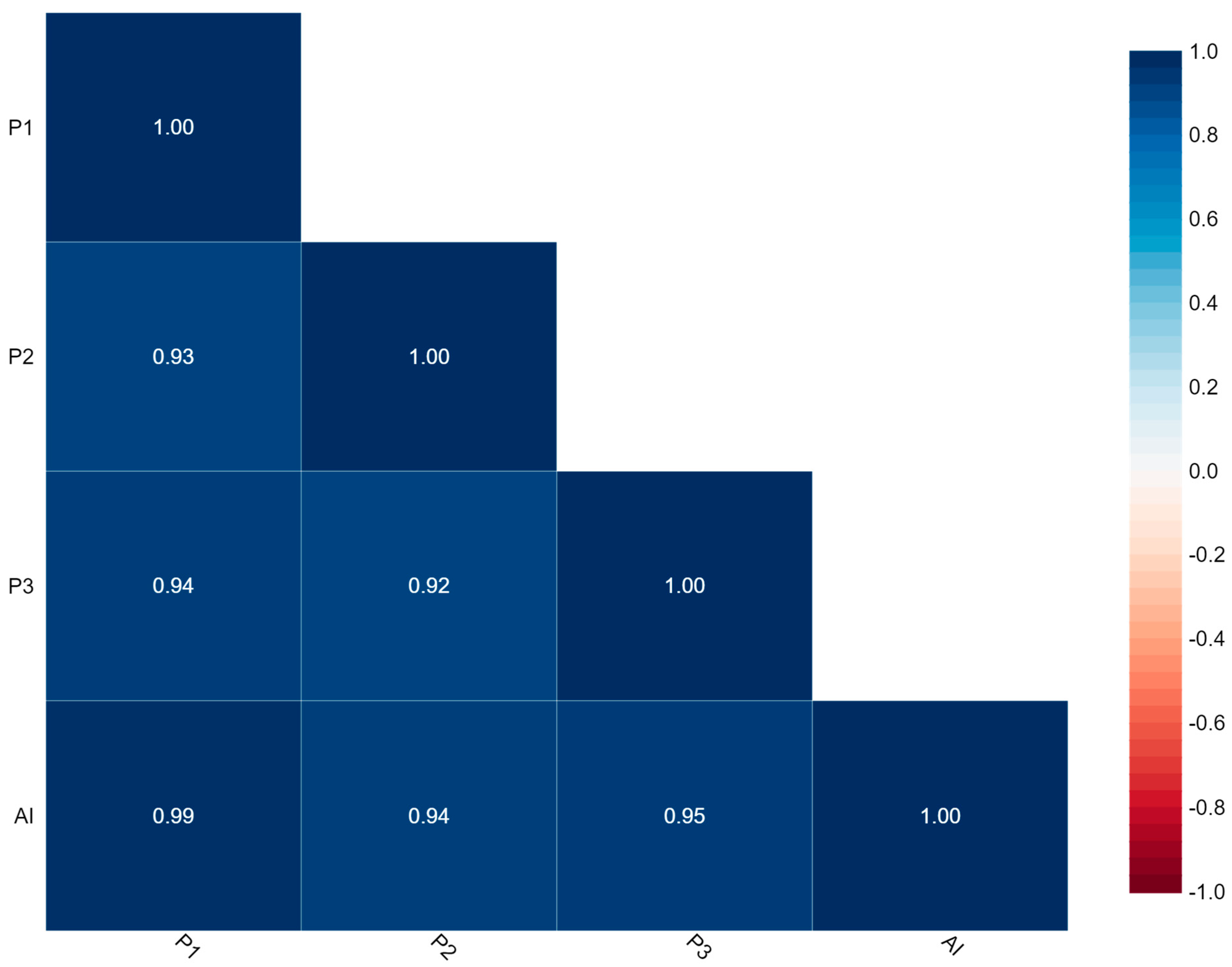
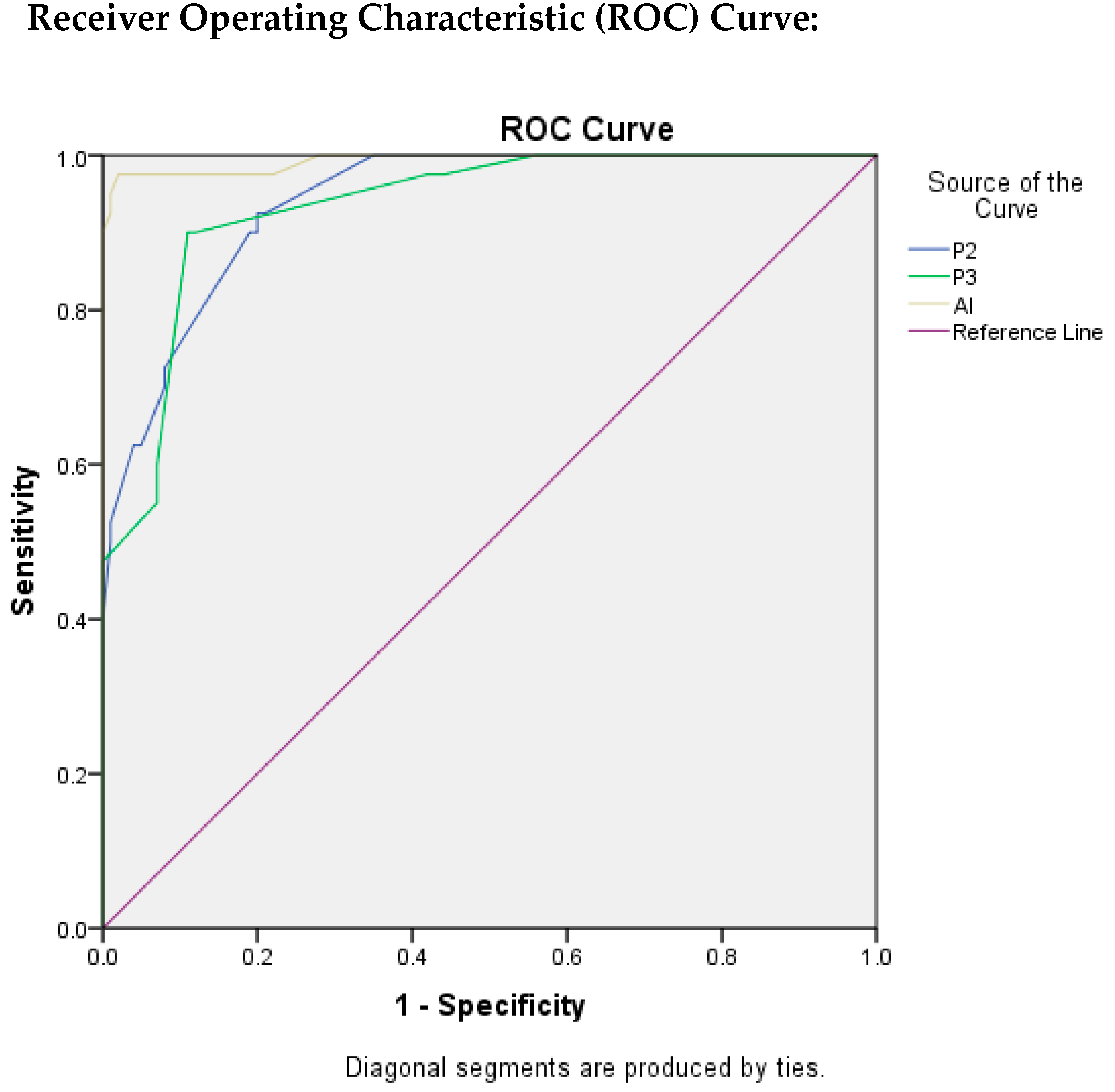

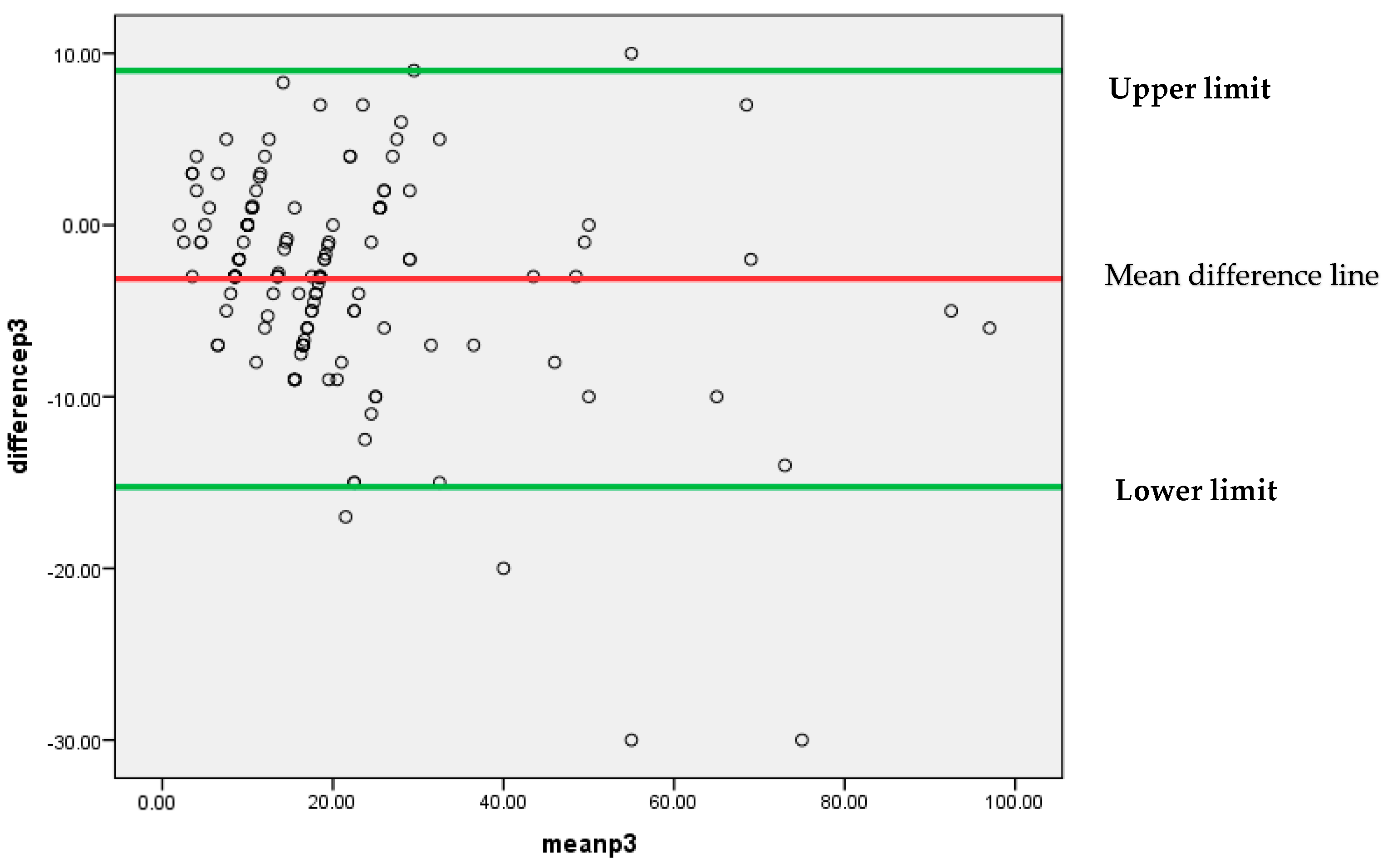
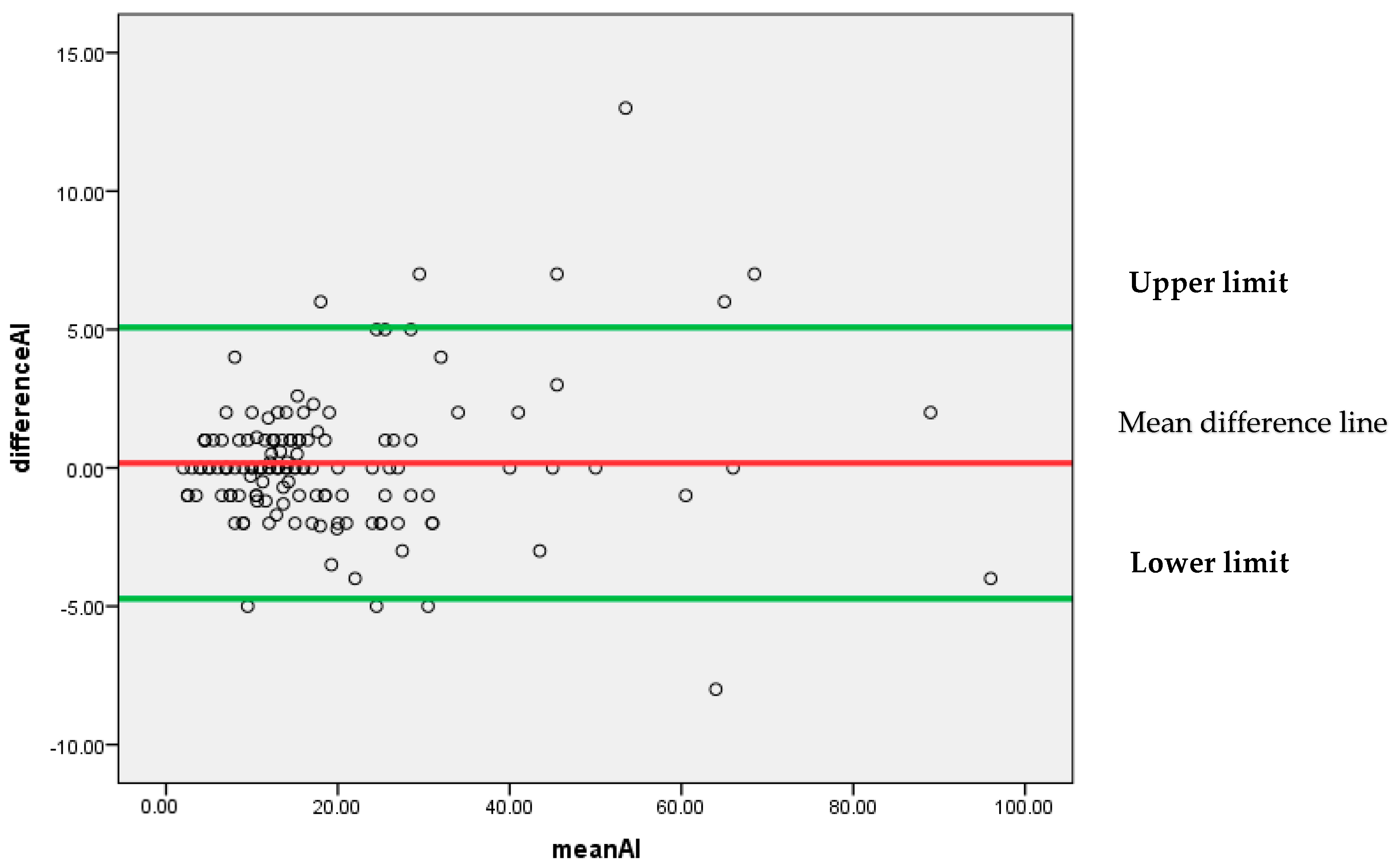
| Variables | Minimum | Maximum | Median | 25th Percentile (Q1) | 75th Percentile (Q3) |
|---|---|---|---|---|---|
| P1 | 2 | 94 | 15 | 10 | 24 |
| P2 | 1 | 100 | 15 | 10 | 22 |
| P3 | 2 | 100 | 20 | 10 | 25 |
| AI | 2 | 98 | 14.15 | 10 | 25 |
| P1 | Total | Kappa | Standard Error | Strength of Agreement | |||
|---|---|---|---|---|---|---|---|
| ≤20 | >20 | ||||||
| P2 | ≤20 | 92 | 11 | 103 | 0.660 | 0.071 | Good |
| >20 | 8 | 29 | 37 | ||||
| Total | 100 | 40 | 140 | ||||
| P3 | ≤20 | 88 | 4 | 92 | 0.736 | 0.061 | Good |
| >20 | 12 | 36 | 48 | ||||
| Total | 100 | 40 | 140 | ||||
| AI | ≤20 | 94 | 1 | 95 | 0.882 | 0.043 | Very Good |
| >20 | 6 | 39 | 45 | ||||
| Total | 100 | 40 | 140 | ||||
| Test Variables | AUC | 95% CI | TEST QUALITY | CUT OFF VALUE | SENSITIVITY (TPR) | 1–SPECIFICITY (FPR) |
|---|---|---|---|---|---|---|
| P2 | 0.940 | 0.904–0.976 | Excellent | 16.5 | 0.925 | 0.200 |
| P3 | 0.934 | 0.893–0.975 | Excellent | 24.5 | 0.900 | 0.110 |
| AI | 0.993 | 0.980–1.000 | Excellent | 21.5 | 0.975 | 0.020 |
| Sensitivity | Specificity | PPV | NPV | DIAGNOSTIC ACCURACY | |
|---|---|---|---|---|---|
| P2 | 92% | 72.5% | 89.32% | 78.38% | 86.43% |
| P3 | 88% | 90% | 95.65% | 75% | 88.57% |
| AI | 94% | 97.5% | 98.95% | 86.67% | 95% |
Disclaimer/Publisher’s Note: The statements, opinions and data contained in all publications are solely those of the individual author(s) and contributor(s) and not of MDPI and/or the editor(s). MDPI and/or the editor(s) disclaim responsibility for any injury to people or property resulting from any ideas, methods, instructions or products referred to in the content. |
© 2023 by the authors. Licensee MDPI, Basel, Switzerland. This article is an open access article distributed under the terms and conditions of the Creative Commons Attribution (CC BY) license (https://creativecommons.org/licenses/by/4.0/).
Share and Cite
Zehra, T.; Jaffar, N.; Shams, M.; Chundriger, Q.; Ahmed, A.; Anum, F.; Alsubaie, N.; Ahmad, Z. Use of a Novel Deep Learning Open-Source Model for Quantification of Ki-67 in Breast Cancer Patients in Pakistan: A Comparative Study between the Manual and Automated Methods. Diagnostics 2023, 13, 3105. https://doi.org/10.3390/diagnostics13193105
Zehra T, Jaffar N, Shams M, Chundriger Q, Ahmed A, Anum F, Alsubaie N, Ahmad Z. Use of a Novel Deep Learning Open-Source Model for Quantification of Ki-67 in Breast Cancer Patients in Pakistan: A Comparative Study between the Manual and Automated Methods. Diagnostics. 2023; 13(19):3105. https://doi.org/10.3390/diagnostics13193105
Chicago/Turabian StyleZehra, Talat, Nazish Jaffar, Mahin Shams, Qurratulain Chundriger, Arsalan Ahmed, Fariha Anum, Najah Alsubaie, and Zubair Ahmad. 2023. "Use of a Novel Deep Learning Open-Source Model for Quantification of Ki-67 in Breast Cancer Patients in Pakistan: A Comparative Study between the Manual and Automated Methods" Diagnostics 13, no. 19: 3105. https://doi.org/10.3390/diagnostics13193105
APA StyleZehra, T., Jaffar, N., Shams, M., Chundriger, Q., Ahmed, A., Anum, F., Alsubaie, N., & Ahmad, Z. (2023). Use of a Novel Deep Learning Open-Source Model for Quantification of Ki-67 in Breast Cancer Patients in Pakistan: A Comparative Study between the Manual and Automated Methods. Diagnostics, 13(19), 3105. https://doi.org/10.3390/diagnostics13193105





